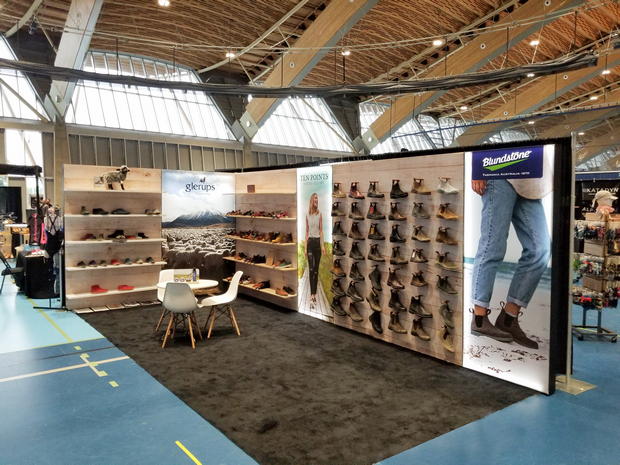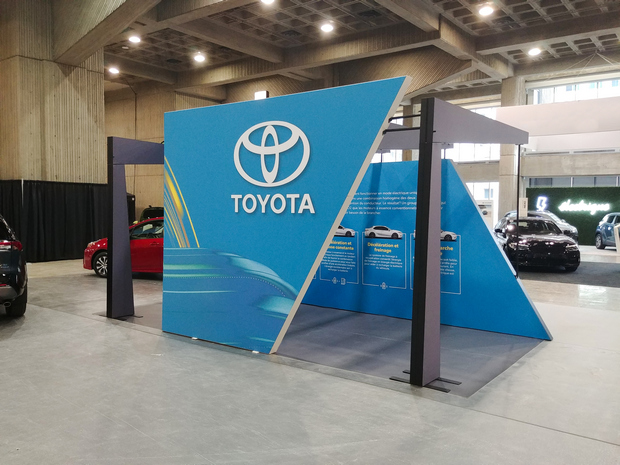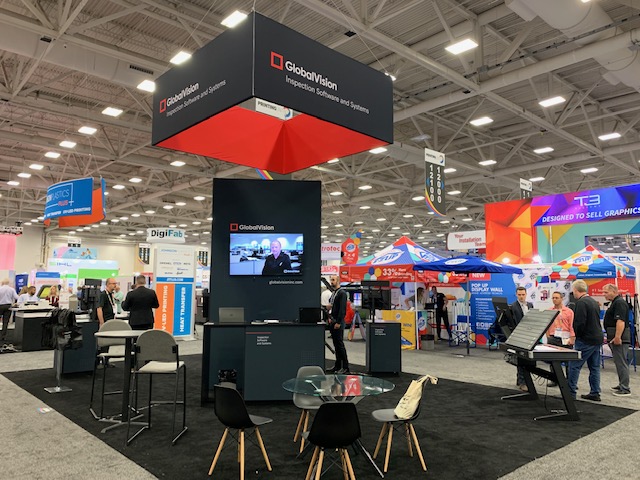With the New Year, come new exhibit trends, ideas and designs to promote brands, connect with their audience and drive sales.
Beyond building powerful brand experiences, these trade show design trends will help brands communicate their message more effectively, develop a better user experience, facilitate their installation process and embrace more sustainable practices, while focusing on their bottom line: saving money.
Let’s get started.
1. Objective-based design
Depending on the objective you want to accomplish, your trade show booth may vary from a more minimalist to a more elaborate design.
- Minimalist design
For exhibitors that wish to put the spotlight on their product, we expect to see more brands embrace more minimalist designs, with simpler exhibits and more neutral backdrops in 2020.
Tin Shack, a wholesale shoe distributor, recently embraced this trend with double-sided Self-Standing Silicone Edge Graphics (SEG) Fabric Lightboxes and two different shoe displays, one with shelving and the other with custom brackets and copper pegs. As the graphics and products were at eye-level, they were able to remain the focal point of the booth.
Tension Fabric Displays and Banner Stands are also effective for this type of design.
To promote a product
- Elaborate design
For exhibitors that want to attract people to their booth, in 2020, we predict to see brands incorporate more elaborate designs, with more modern exhibits, innovative products & creative lighting.
As Toyota had some electric cars on display at the electric car show, it chose a futuristic exhibit, with an asymmetrical design and LED lighting, to draw people to its booth. Visible from across the show floor, this type of exhibit helped encourage foot-traffic to its booth, where visitors were able to learn more about Toyota’s latest products.
3D ObjeX, projection mapping and motion lightboxes are other ways exhibitors can create a wow-factor to bring people to their booth.
To stand out
- Combining both
For those that are looking to promote their products and draw people to their booth, we foresee exhibitors embrace a combination of minimalist design with eye-catching elements in 2020.
Maxam, a specialty tire manufacturer and distributor, used backlit arches as well as simpler graphics and product displays to draw people to its booth and promote its products.
To promote a product & stand out
2. Overhead Signs
Can’t miss them
Beyond gaining better visibility, hanging signs allow exhibitors to optimize their space, from the reception level to the highest point available.
While more standard shapes, like the FabGraphics Halo, have been popular in the past, we expect to see more demand for custom sizes & shapes in 2020.
Stand out on the show floor
3. Creative lighting
Light up your space
Following an increase in popularity in backlit graphics in 2019, we expect brands embracing the trend more & more in 2020.
Beyond SEG Fabric Lightboxes, we expect to see brands using other types of creative lighting, like projection mapping or motion lightboxes, to attract visitors to their trade show booth and create an immersive environment.
Draw guests to your booth
4. User-experience (UX) considerations
Encourage brand engagement
Beyond creating an attractive space, in 2020, we anticipate brands considering the user experience (UX) to improve the usability, accessibility, and desirability of their trade show booth. The UX considerations below encourage visitors to engage with brands:
- Interactive elements (ie. games, trivia, contests, product demonstrations & trials);
- Branded giveaways;
- Straight-forward and informative graphics;
- Easy to navigate layout;
- A lounge area with home furnishings;
During the design and fabrication stage, PNH Solutions offers a complimentary service that allows brands to view their trade show booth in virtual reality (VR) and augmented reality environment. Using a gaming controller, exhibitors are able to navigate through and around their product as a fictional character to view their product in a 3D environment and make any adjustments to favor a better user experience.
By encouraging engagement, a UX-optimized trade show booth not only attracts visitors to it but prompts them to stay. As a result, they are able to learn more about the brand and take action.
Generate leads with a UX-optimized booth
5. Tool-free assembly
No tools, no problems
It’s no surprise that this trend became more popular in 2019 and that it is here to stay in 2020. Without tools, exhibitors are able to put up their trade show booth more easily and quickly, without professional help, which helps them avoid additional costs.
Global Vision’s trade show booth proves that having a tool-free assembly doesn’t involve settling for a smaller, less powerful product. Despite being 16’ tall, they were able to set it up without tools, even without a ladder, by laying it on the floor and then tilting it up. While they needed help mounting their hanging banner, Global Vision was able to assemble it. Visible from across the trade show floor, Global Vision was able to advertise its brand and attract people to its booth.
Forego installation costs
6. Compact, deployable structures
The smaller & lighter the crate, the better
After a steady rise in popularity in 2019, we expect to see more exhibitors favor compact, deployable structures in 2020, as they allow them to save money before, during and after their event. While shipping and warehousing costs may first come to mind, there is another, lesser-known, cost: drayage i.e., moving your shipping container from the venue’s loading dock to the show floor.
According to the 2017 Exhibition and Event Industry Labor Rates Survey, the Canadian average drayage rates (per CWT) were estimated at $78.33 for direct crated shipments to an exhibit hall. For advance shipments, uncrated shipments or shipments that require special handling, the rate is even higher.
As Tin Shack was planning on attending trade shows across Canada, it was looking to keep its costs as low as possible. With a modular design and lightweight materials, it was able fit its 10’ x 20’ trade show booth into two shipping crates, which helped it reduce the cost of its freight and save money throughout its campaign.
Spend less on shipping, drayage & warehousing costs
7. Greater environmental-driven practices
Recycle, reuse, repurpose
With growing concerns for the environment, there is growing demand for more sustainable practices in architecture and trade show booth design.
Rather than wanting a custom booth for every single show, we expect to see more brands opting for flexible structures that they can reuse for different events. As they can shrink and expand as needed, they can be used for different booth sizes. Using SEG Fabric Frames and Lightboxes, exhibitors can replace their graphics, easily and quickly, depending on the product or service they wish to promote.
Beyond reusing their trade show booth, brands can also upcycle it, meaning that they can use it as part of another project. By reusing or upcycling their trade show booth, brands don’t only gain more value from it; they are also able to reduce their waste, which in turn help them save money.
Lean and green
By embracing these 2020 trade show design trends, your exhibit is more likely to become a brand-building, visitor-engaging, lead-generating success.
To get started on your project, contact us today.



